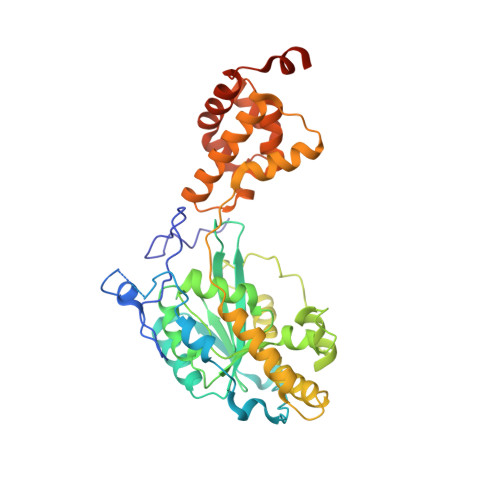Activities of human RRP6 and structure of the human RRP6 catalytic domain.
Januszyk, K., Liu, Q., Lima, C.D.(2011) RNA 17: 1566-1577
- PubMed: 21705430
- DOI: https://doi.org/10.1261/rna.2763111
- Primary Citation of Related Structures:
3SAF, 3SAG, 3SAH - PubMed Abstract:
The eukaryotic RNA exosome is a highly conserved multi-subunit complex that catalyzes degradation and processing of coding and noncoding RNA. A noncatalytic nine-subunit exosome core interacts with Rrp44 and Rrp6, two subunits that possess processive and distributive 3'-to-5' exoribonuclease activity, respectively. While both Rrp6 and Rrp44 are responsible for RNA processing in budding yeast, Rrp6 may play a more prominent role in processing, as it has been demonstrated to be inhibited by stable RNA secondary structure in vitro and because the null allele in budding yeast leads to the buildup of specific structured RNA substrates. Human RRP6, otherwise known as PM/SCL-100 or EXOSC10, shares sequence similarity to budding yeast Rrp6 and is proposed to catalyze 3'-to-5' exoribonuclease activity on a variety of nuclear transcripts including ribosomal RNA subunits, RNA that has been poly-adenylated by TRAMP, as well as other nuclear RNA transcripts destined for processing and/or destruction. To characterize human RRP6, we expressed the full-length enzyme as well as truncation mutants that retain catalytic activity, compared their activities to analogous constructs for Saccharomyces cerevisiae Rrp6, and determined the X-ray structure of a human construct containing the exoribonuclease and HRDC domains that retains catalytic activity. Structural data show that the human active site is more exposed when compared to the yeast structure, and biochemical data suggest that this feature may play a role in the ability of human RRP6 to productively engage and degrade structured RNA substrates more effectively than the analogous budding yeast enzyme.
- Structural Biology Program, Sloan-Kettering Institute, New York, New York 10065, USA.
Organizational Affiliation:


















